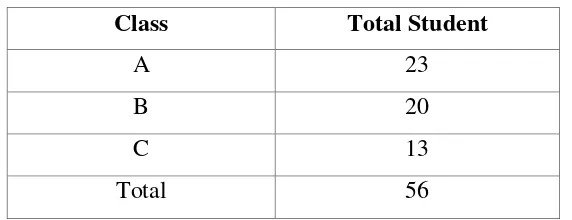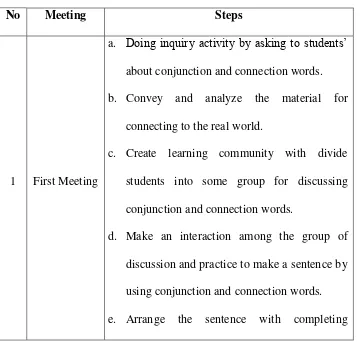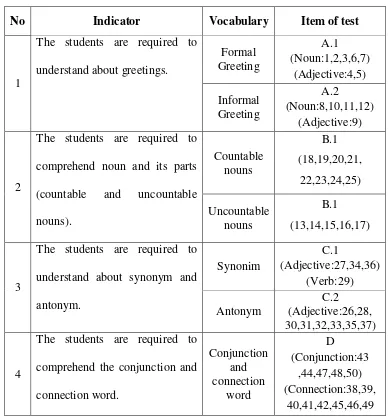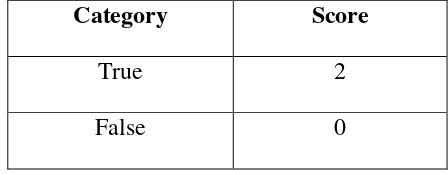32
A. Research Type
This Research used quantitative approach. Aliaga in Daniel claims that Quantitative research is explaining phenomena by collecting numerical data that are analyzed using mathematically based methods (in particular statistics).1 The quantitative approach is used when one begins with a theory (or hypothesis) and tests for confirmation or disconfirmation of that hypothesis.2
B. Research Design
In this research, writer used the experiment research. Danim in Syamsuddin, points out that research experiment intended to investigate the possibility of cause and effect relationship, by exposing one or more experimental group and one or more experiment condition. The result was compared with one or more control group which was not subjected to treatment. Whereas Gay in Sukardi explains that control is an effort on the part of researcher to remove the influence of any variable other than the independent variable that effect performance on a dependent variable.3Experimental design may also be classified to how well they provide control of the threats to internal validity: pre-experimental, true
1
Daniel Muijs, Doing Quantitative Research in Education with SPSS, London: Sage Publication, 2011, 2nd edition, p.1
2
Isadore Newman, & Carolyn R. Benz, Qualitative-Quantitative Research Methodology: Exploring the Interactive Contimum, United Stated of America: Southern Illinois University, 1998, p.3
3
experimental, and quasi- experimental designs.4 In this research, writer chooses to use quasi- experimental designs.
The group pretest-posttest design usually involves three steps: (1) administering a pretest measuring the dependent variable; (2) applying the experimental treatment X to the subjects; and (3) administering a posttest, again measuring the dependent variable. Differences attributed to application of the experimental treatment are then evaluated by comparing the pretest and posttest score.5
Table 3.1 Quasi - Experimental Design
Pretest Treatment Posttest
Experimental
Group X X X
Control Group X X
C. Population and Sample
1. Population
A population is defined as all members of any well-defined class of people, events, or objects.6 Population is the generalization that occurred over the subject/object: have certain qualities and characteristics set by the researchers to learn and then drawn the conclusion.7 Population of this research is all of students of English study program at State Islamic Institute.
4
Donald Ary, Lucy Cheser Jacobs, Chris Sorenses&AsgharRazavieh, Introduction to Research in Education, Canada:Nelson Education, 2010, 8th edition, p.302
5
Ibid.,p.304 6
Donald Ary, Lucy Cheser Jacobs, Chris Sorensen, Introduction to Research in Education,
Wadsworth: Cengage Learning, 2010, Student Edition, p. 148 7
There are threeclasses of English Study program where each class has 13-23 students. Total class and students may see on the table below:
Table 3.2 Population
Class Total Student
A 23
B 20
C 13
Total 56
2. Sample
Is said to be simple due to the taking of samples from a population of members is done at random without regard to existing strata in the population.Each population is given a number, then the sample that desired drawn according to random, either by using random numbers or with a regular lottery.8 A sample is a portion of a population. The writer took the sample from the population. In this research, writer took the sample using simple random sampling technique. Here, class Cbecome experimental class. They represent population.
D. Data Collection Procedure
In this study, the writer used some procedures to collect the data. The procedures consist of some steps as follows:
1) Giving pre-test of vocabulary test to the students in experimental class (class C on Monday, September 7th2015) and control class (class A on
8
Tuesday, September8th2015) of English study program at State Islamic College of Palangka Raya.
2) Collecting the data of student’s work sheet pretest result. 3) Giving score the students test result by using the formula:
Score: B
N× 100%
B : frequency of the correct answer N : Number of test item
4) Applying treatment to students, its teaching vocabulary using Contextual Teaching and Learning in experiment class.
Table 3.3 Procedure Teaching Using CTL
No Meeting Steps
1 First Meeting
a. Doing inquiry activity by asking to students’ about conjunction and connection words. b. Convey and analyze the material for
connecting to the real world.
c. Create learning community with divide students into some group for discussing conjunction and connection words.
conjunction and connection words. f. Giving response about students work.
g. Provide feedback on the process and outcomes of learning.
h. Summarizing the connection between material and real word
2 Second
Meeting
a. Doing inquiry activity by asking to students’ about irregular verbs.
b. Convey and analyze the material for connecting to the real world and give an example of irregular verbs using picture. c. Create learning community with divide
students into some group for discussing irregular verbs
d. Make an interaction among the group of discussion and practice to divide irregular verbs among picture that will show.
e. Giving response about students work.
f. Provide feedback on the process and outcomes of learning.
3 ThirdMeeting
a. Doing inquiry activity by asking to students’ about countable and uncountable noun. b. Convey and analyze the material for
connecting to the real world and give an example of countable and uncountable noun using picture.
c. Create learning community with divide students into some group for searching noun around and ask them to divide into countable and uncountable noun.
d. Make an interaction among the group of discussion and ask each group to perform countable and uncountable noun that they find around.
e. Giving response about students work.
f. Provide feedback on the process and outcomes of learning.
g. Summarizing the connection between material and real word.
4
Fourth Meeting
a. Doing inquiry activity by asking to students’ about preposition.
c. Create learning community with divide students into some group for discussing preposition according to their experience about preposition.
d. Make an interaction among the group of discussion and practice to make a sentence by using preposition in each sentence.
e. Arrange the sentence with completing preposition.
f. Giving response about students work.
g. Provide feedback on the process and outcomes of learning.
h. Summarizing the connection between material and real word.
5) Giving post-tests to the students after applying Contextual Teaching and Learning on vocabulary activity.
6) Collecting the data of student’s work sheet post-test result. 7) Giving score the students post-test result
E. Research Instruments
1. Try Out
program. Then, writer took the information and result about the instrument quality that consists of instrument reliability, instrument validity, index of difficulty and test normality. In this study, writer used gap-fill test to check the students’ vocabulary mastery.9
In this study, writer did the try out test to the studentsin class B. It the another class at the same level of sample. The writer tried out the test instrumrnt on semptember 1st 2015. Test item of try out was vocabulary test especially gap-fill test. The purpose of try out test is to know the students’ vocabulary mastery. Writer took the question of test item from some books, namely English vocabulary in use (elementary), Essential Vocabulary, synonyms and antonyms. The result of try out test was calculated for selecting the significant items. In this case, the writer used KR.21 formula to check instrument reliability, inter-rater and pearson product moment to check instrument validity, and ana-test application to check the index of difficulty. 2. Test
Testing provides a form of feedback, both for learners and teachers. Without testing, there is no reliable means of knowing how effective a teaching sequence has been. Testing motivates learners to review vocabulary in preparation for a test. It also provides an excuse for further, post-test, review- when, for example, the teacher goes over the answers in class. Test of vocabulary knowledge sometimes from a part of placement tests, or as a component of a diagnostic test in advanced of planning a course program.
9
Such test usually involves some attempt to measure extent of vocabulary knowledge.10There are two kinds of testing, that is objective test and subjective test. In this study, writer used subjective test as research instrument.
Subjective test is one form of the test which is used also in the research instrument.This test is meant to see the various capabilities of the subject in written form.Essay test items demand the students to organize or present the answer in the form of descriptions.Subjective test is divided into four parts, namely: free description form, a form of structured or limited description, forms short answer, completing.Among all of kinds of subjective test, writer used completing test. Test item "completing" is almost the same with short answer, which is a type of test item that can be answered with words, phrases, numbers, or symbols.The difference between test items "completing" statement is not complete and the students are required to complete the statement.11
There are three types of vocabulary test; those are multiple choice test; gap-fill test and cloze test. In this research, writer choosesgap-fill tests for testing vocabulary.Gap-fill tests require learners to recall the word from memory in order to complete a sentence or text.12 Thus they test the ability to produce a word rather than simply recognize it. The best-known example of this test type is the cloze test. In a cloze test, the gaps are regularly spaced – e.g. every seventh, eight, or ninth word. In this way, knowledge of wide range
10I
bid.,p.83 11
HamzahB.Uno., &SatriaKoni, AssesmentPembelajaran, Jakarta: BumiAksara, 2013, p. 116-118 12
of word types including grammar words as content words as well as content words is tested. Moreover, the ability to complete the gaps depends on understanding the context.
In this case, the writer choose subjective test especially gap-fill test because according to Thornbury that the test can be steered more towards content words, and hence become a more valid test of vocabulary. Most teachers will be familiar with tests of selective (or open) cloze type, although it is more often used to test grammar than vocabulary. The problem with gap-fills, however is that there is often more than one possible correct answer, which makes scoring difficult.13For example:14
One of the varieties of gap-fill tests learners’ knowledge of word formation by asking them to convert words from one form to another so as to fit a context. For example:
Change the word on the left into a suitable form to fill the gap:
13
ThornBury.,op.cit,p.133 14
Michael McCharthy Felicity O’Dell, English Vocabulary In Use Elementary,Combridge: University Press, 2000, p.35
I love swimming and my brother loves swimming
(1)………..
. Almost all my family loves swimming.
(2)………... my grandmother swims every day.
She swims (3)………... a fish.
(4)……….my father doesn’t like it very much.
I can swim better (5)... my family.
1. Compose On one occasion the opera was conducted by the ______
This kind of task tests learners’ knowledge of derivations (composer and
misplaced as opposed to, say, the incorrect compositor or displaced). It also tests their ability to interpret the surrounding context, in order to make the correct choice among several possible derivations (not composure or displaced, for example):15
Table 3.4 Specification of Test Items.
No Indicator Vocabulary Item of test
Total of test item 50
3. Pre-test and posttest
The writer gavepretest instrument before applying to the real sample in the study. Then, writer took the information and result about the instrument quality that consists of instrument reliability, instrument validity, index of difficulty and test normality.
In this study, writer used gap-fill test to check the students’ vocabulary mastery. Gap-fill tests require learners to recall the word from memory in order to complete a sentence or text.16 There are four materials that used in pretest and posttest activity; those are greetings, countable and uncountable noun, synonym and antonym, and conjunction as shown in specification items in table 3.4.. There are 7-13 questions for each material, so there are 50 questions total of test item.
Table 3.5Example of Scoring Guide for Vocabulary Assessment
Category Score
True 2
False 0
4. Research Instruments Reliability
Reliability of a measuring device is the degree of permanence of the tool in measuring what is measured. Reliability is affected by random errors, which is a factor that would cause a difference in score in the use of gauges repeatedly. To find out we're considering random error or mistake systematically. A test of reliability is expressed mathematically as a best guess about some proportion of the variance total score which is the true variance. There are two approaches to reveal a set of measurement reliability, i.e.: (1) indicates multiplicity of variance/ differences which expected in the set of measurements that are repeatedly concerning an individual; (2) shows how much each individual retains its relative position within the group.
Reliability can be estimated by means of correlating scores obtained one at different times or with groups of questions is worth it. This procedure requires the implementation of the test twice. Other procedures performed with the artificial divide one test into two equal parts or by way of internal tests are established.17
Reliability estimates are used to evaluate (1) the stability of measures administered at different times to the same individuals or using the same standard (test–retest reliability) or (2) the equivalence of sets of items from the same test (internal consistency) or of different observers scoring a behavior or event using the same instrument. Reliability coefficients range from 0.00 to 1.00, with higher coefficients indicating higher levels of
17
AriefFurchan, MA., Ph.D, PengantarPenelitiandalamPendidikan (terjemahan Donald Arydkk),
reliability. In this study, the writer uses Kuder-Richardson 21 (K-R21) as the formula to instrument reliability from the test result.
K-R21
=
K but an instrument can be reliable without being valid.18The validity of an instrument is always dependent upon the situation and the specific purpose of use of the instrument. Classification of types of validity to the most famous has done by Joint Commission the American Psychological Association, AERA, and the National Council on Measurement in Education. The Commission distinguishes three types of validity: content validity (validity associated with criteria (criterion-related validity), and the
18
validity of notions (construct validity), these three types of validity include the basic purpose of the test.
a. Content validity
Content validity refers to the extent to which these instruments reflect the desired content. The validity of the contents cannot be revealed by number, validation content and basically had to be based on the consideration, and the consideration to be done separately for each situation. The user should consider whether the test contents and objectives measured by these tests reflect the content and objectives contained within the content. If all the reviewers agreed that details of the tests already reflect the contents with adequate, then these tests can be said to have had the validity of the content. it also proved that such tests are free from the influence of factors that have nothing to do with the purpose of measurement.19
In this study, the writer would measure vocabulary mastery. The writer used vocabulary test in the form of gap-fill test which consist of 50 items. The gap-fill test was based on syllabus of vocabulary in English study program. To fulfill the content validity, the test was directly related to vocabulary material that will teach to students. b. Validity associated with criteria (criterion-related validity)
The validity of the associated with the criteria refers to the relationship between the score of a measurement instrument with a
19
variable (criteria) out of an independent and is believed to be able to measure directly the behavior or the traits investigated. In contrast to the validity, validity content associated with this criterion using empirical techniques to investigate the relationship criteria score instrument which is being questioned by criteria outside. There are several characteristics which must be owned by a measure of the criteria, namely relevance, reliable (trustworthy), and free of refraction (granting score on a measure criteria should not be influenced by factors other than the actual appearance).
c. Construct validity
test score with other observations should be consistent with understanding.20
The writer use product moment correlation as the formula to calculate the validity from the test result.
𝑟𝑥𝑦 = 𝑁 ∑𝑋𝑌 − ∑𝑋
. (∑𝑌)
[𝑁.∑𝑋2− (∑𝑋)2][𝑁∑𝑌2− (∑𝑌)2]
Where:
rxy : Index Correlation Number “r” Product Moment
N : Number of Cases
∑XY : Multiplication Result between score X and score Y
∑X : Total Value of Score X
∑Y : Total Value of Score Y.21
F. Data Analysis Procedure
Bogdan and Biklen claim that the data analysis is the tracking process and sistematically setting transcript of the interview, field notes, and other materials which collected to increase the understanding of the materials to be presented to others. Furthermore, Bogdan and Biklen explain that data analysis involve the processing data organization, process of sorting become certain units, synthesis of data, tracking pattern, discovery the important things that learned, determining what should be presented to others.22
20
Ibid.,p.294-303 21
AnasSudijono, PengantarStatistikPendidikan, Jakarta:PT Raja GrafindoPersada, 1997, p.193 22
The writer analyze data acquired to answer the problem of the study about the effectiveness of using Contextual Teaching and Learning Approach toward the
student’s vocabulary mastery at English Study program in the first semester as follows:
1) Tabulating the data into distribution of frequency of score table, then find
out the mean of students’ score, standard deviation, and standard error of
variable X1 (experimental group) and X2 (control group).
2) Calculating the data by using t-test to test the hypothesis of the study,
whether the using CTL approach gives effect to the students’ vocabulary
mastery or not. To examine the hypothesis, the writer used t-test formula as follows:23
Where:
t
o : “t” arithmeticMD : Mean of Difference
Can be found by formula:
∑D : Total of difference between score of variable X and variable Y
SEMD : Standard Error from Mean of Difference which can be
found by formula:
23
TriwidSyafarotunNajah, Statistik Pendidikan,2012, p.92-93
MD = ∑
D N
SEMD
SDD
N−1
t
o =M1 −M2
SDD : Standard Deviation from Difference that can be found by
formula:
If t-test ≥ t table, Ha is accepted and Ho is rejected
If t-test < t table, Ha is rejected an Ho is accepted
3. Comparing the result of t-test with table 4. Interpreting the result of t-test.
Afterwards, the value of t-test was consulted on the t-table at the level of significance 5% and 1%. If the result of t-test is higher than t-table, it means Ha is accepted. But if the result of t-test is lower than t-table,
it means Ho is accepted.
5. The writer made the conclusion of data analysis obtained.
6. Discussing to verify the research findings and conclusion the result of data analysis.
SDD =
∑FX2



